By Amy Dawes
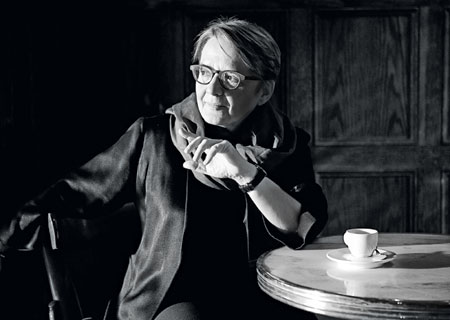 Holland considers herself an eclectic director who is comfortable in different styles and cultures. (Photo: Sony Pictures Classics)
Holland considers herself an eclectic director who is comfortable in different styles and cultures. (Photo: Sony Pictures Classics) Agnieszka Holland may be best known in the cinema world as a European art house director of films weighted with historic and political gravitas, such as the Holocaust-related feature In Darkness, made in her native Poland and nominated for an Academy Award for best foreign film this year. But she is also making her mark as a skilled director in the realm of American cable television. At 63, she has become a cultural chameleon, skipping from Central and Western Europe to the United States, and from film to television, in pursuit of art and opportunities.
"I'm an eclectic director. I do things that involve many different styles and realities and cultures," Holland says, speaking by phone from Warsaw. She had just wrapped production there on Burning Bush, an ambitious three-part series that represents a new foray into original programming by HBO Central Europe.
She begins recounting her peripatetic career by talking about Treme, the critically acclaimed HBO series created by David Simon and set in post-Katrina New Orleans. Holland, who had worked with Simon previously on The Wire, directed the pilot and several other episodes. What stood out about Treme when it premiered in April 2010 was how vividly it captured the point of view of musicians in the city's traditional brass band street parades.
For Holland, it was her first encounter with New Orleans. Being an outsider to a culture, she says, can lead to vibrant results onscreen. "That freshness is in some ways a blessing. Everything for me was like in childhood—discovering the world, and the sensuality of those feelings."
Its opening sequence in particular is striking. The first thing we see is a series of extreme close-ups, backed by the laconic sounds of musicians tuning up. Trumpet keys are lubed. Liquor is poured into a plastic cup. A cigarette dangles from coal-black fingers. White feathers on a Mardi Gras costume ruffle in the breeze.
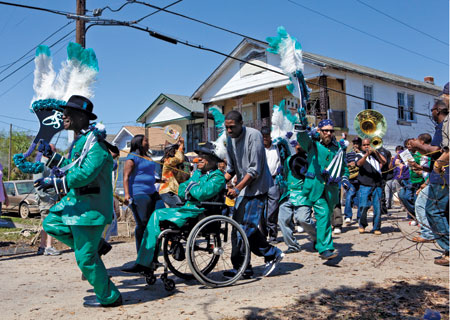 CHANGE OF PACE: In the pilot for Treme, Holland shot musicians in the band shuffling down a damaged street in New Orleans with an artful disregard for technical perfection. (Photo: Skip Bolen/HBO)
CHANGE OF PACE: In the pilot for Treme, Holland shot musicians in the band shuffling down a damaged street in New Orleans with an artful disregard for technical perfection. (Photo: Skip Bolen/HBO) As it continues, one senses an artful audacity in the director's disregard for technical perfection. When the musicians in the band come spinning and shuffling down a damaged street, the view is partially blocked by an abandoned, rusting appliance. A youth who dances on a dented car roof is framed from the shoulders down. Close-range distractions pass constantly between the camera lens and its target; images blur and return to focus.
The result is the sensation of experience the way it actually occurs—haphazard but intensely felt. This is just what Holland says she intended. The parade is a kind of rebirth, the first time the musicians have assembled since the hurricane dealt its grievous wound to their city.
"We had to build up the expectation, the waiting, and tension," says Holland. "I wanted the viewer to take the point of view of those musicians, so the camera is moving with them all the time. I'm using long, following Steadicam shots intercut by quick, short shots. The viewers have to feel that they are inside of this—that they are not tourists watching, but that they are right in the middle of it. My ambition is always to find the point of view, the small stylistic or technical devices that will help show the reality of a particular scene in a more personal and sensitive way."
Holland had taken a similar approach on The Wire, a series acclaimed for the gritty authenticity with which it depicted Baltimore's urban drug trade. Holland did her first episode when the show was well into its third season. She says that, in many ways, made it easier to direct The Wire.
"The vision I served had already been established by Simon, the pilot's director [Clark Johnson], and the directors of the first episodes. The writing was so precise and the casting and characters so strong that I knew immediately where to go: just do what was on the page, though it's sometimes under the surface."
Holland says she sometimes finds her way into a script by looking for an element missing from the writing that she can supply. In the case of Simon's work, it is often a cinematic, sensual dimension. "I try to add a grain of unconventional tension, both visual and interpersonal," she says. "Of course, the style of The Wire and Treme has to be very different. Baltimore is brutal, violent, dirty and desperate, while New Orleans, even after Katrina, has some hope and a crazy, sensual energy that is expressed through the music. I start with the script and the reality of the world where it takes place, but I am always looking for the style."
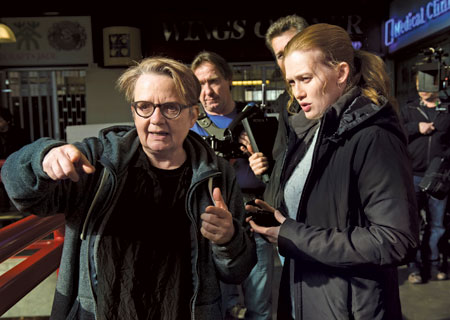 Holland, directing Mireille Enos, brought a cinematic style to the visually rich The Killing. (Photo: Carole Segal/AMC)
Holland, directing Mireille Enos, brought a cinematic style to the visually rich The Killing. (Photo: Carole Segal/AMC) Holland's most recent work in television has been on AMC's moody, visually rich crime drama The Killing, set in a rainy, haunted Seattle (and shot in Vancouver). She has directed several episodes, including the two-hour season two premiere. As was the case with Simon, she had worked with the show's creator, Veena Sud, on a previous series, the CBS crime drama Cold Case.
Holland says that to do one's best work in television, it helps to partner with a producer who has a shared sensibility. "It means the collaboration will be very creative, because you understand each other."
She says of Sud: "She combines very efficient storytelling with an ambition to make it stylistically different. She's not a big fan of the quick action style. She prefers things that are in some ways like good European movies. When she showed me the pilot for The Killing, I immediately knew I wanted to do it, because it was very different."
Sud explains that in turn, what she seeks from Holland is "her cinematic vision, both in how she frames her shots to tell a story, and in her insight into the complicated nuances of human interaction. She has a great eye, both literally and metaphorically, for every beat of a story, and for how a scene serves the underlying themes and truths of the characters."
After the two worked together on Cold Case, Sud says she sought out Holland again for The Killing. "Ag is one of the most intensely committed people I've worked with," says Sud. "And not only that, she's hilarious. I've laughed a lot with her on set. She always knows how to cut through the shit and say it like it is."
No one would say that Holland was raised in ordinary circumstances. She grew up in Warsaw surrounded by political ferment. Her parents were both journalists, well-known figures in the intellectual and cultural life of the city. Her father was a Jew and her mother was a Catholic activist who aided the Jewish resistance during WWII. She describes her childhood as "very sensual, very intense, but not entirely happy."
When she was 13, her father was arrested by the state military police and died during the interrogation. It was later determined that he committed suicide by jumping from a window. She says the suddenness of the loss, the sense that one's world could be instantly ripped apart, was a formative experience. By the time she was 15, Holland had embraced her artistic and rebellious nature. "I was fearless and thought I had to try everything—drugs, politics, sex—if I wanted to be an artist."
She was also seeing more than a dozen movies a week, exposing herself to Bergman, Fellini, and the French New Wave, along with Polish filmmakers like Andrzej Wajda, with whom she would later apprentice. "It was a time when the European cinema was very alive, very surprising," she says. "It was the art form of great individuals." By age 16 she had settled on filmmaking as a career. "I thought I was somebody like Rimbaud, and that I could do something that would make people understand things in a completely different light."
At that time, Czechoslovakian cinema was particularly vibrant, and in 1966 Holland entered the Prague Film Academy. Her teachers would include directors Jiri Menzel (Closely Watched Trains) and Elmar Klos (The Shop on Main Street), and writer Milan Kundera (The Unbearable Lightness of Being). She describes her attitude at the time as "rebellious, and incredibly insolent," adding, "I had to try my professors; I had to see what I could get away with."
In 1968 an important political shift occurred in Poland—the movement toward democratization that became known as the Prague Spring. "It was like an explosion of freedom," she recalls. "All the censorship melted away and there were incredible events and discussions. It was like a festival of joy and freedom. Then the Soviets decided that maybe this freedom was too dangerous."
In August of '68 the Soviets invaded. Holland remembers running in the streets among the tanks. Later, when the so-called normalization set in, she plotted with other students to publish underground newsletters of dissent. She was arrested and imprisoned for seven weeks, including a week spent in total isolation. "It was very unpleasant, but extremely interesting because I got to see how strong I can be in those circumstances," she remembers.
For Burning Bush, which she is currently editing, Holland was able to draw on those experiences. The miniseries is about the Prague Spring crackdown and a young student, Jan Palach, who set himself on fire as a form of protest. "Everything that the script covers, I was very engaged in," she says.
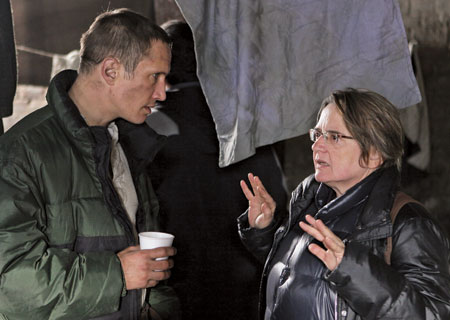 For her Holocaust-related feature In Darkness, with Benno Furmann, Holland didn't want it to look glamorous or beautiful in any way. (Photo: Sony Picture Classics)
For her Holocaust-related feature In Darkness, with Benno Furmann, Holland didn't want it to look glamorous or beautiful in any way. (Photo: Sony Picture Classics) Looking back at Holland's early life, one can readily trace the roots of thematic concerns and sensibilities that would be reflected throughout her oeuvre, which includes 34 feature films.
For example, her youthful infatuation with Rimbaud and his coarse, insolent way of testing the world came to the fore in her 1995 film biopic of the French symbolist poet, Total Eclipse, starring Leonardo DiCaprio and David Thewlis.
The turbulent, religiously divided household in which she was raised would be reflected over and over again in works that explored religious and spiritual conflicts, such as The Third Miracle (1999) and To Kill a Priest (1988).
The traumatic legacy of her Jewish roots was confronted repeatedly in Holocaust-themed works such as Angry Harvest (1985) and Europa, Europa (1990), both of which were Oscar-nominated.
And always, there were stories of alienation and misplaced identity, of outsiders trying to regain a sense of home, such as Olivier, Olivier (1992), about a teenage male prostitute in Paris who is reunited with a family he mysteriously vanished from at the age of 9.
To Holland, the demands placed upon her by her life's upheavals have in some ways been the ideal training for the work she would take on.
"For me, to be a director is not only to impose my vision, but also to be open, to take in other realities," she says. "I'm always curious, reading and watching a lot of things and analyzing. But when I'm directing I try to forget a lot of this. My method is to be open all the time and pay a lot of attention to what's going on in front of me."
To observe how Holland's style has evolved over time, one can compare the critically acclaimed Europa, Europa with last year's In Darkness.
Both tackle true-life Holocaust accounts. Europa, Europais based on an autobiography by Solomon Perel, a German Jewish boy who survived the war by pretending to be Aryan and gaining acceptance into a brigade of the Hitler Youth academy. Like many of Holland's works, it begins with bold, earthy images—a rabbi circumcises an infant, two women waltz around a dining room table, a young boy climbs into a washtub, then leaps naked from a window when Nazis attack the house. It includes numerous surreal flourishes, dream sequences, and symbolic interludes: in one, the boy almost comically imagines meeting Hitler and interacting with him.
"I took a light, playful approach to a tragic historical subject, and in its time, this was quite original," says Holland. "The character was an innocent young boy, and I was telling it like it was Candide, or a comic book. I think this made it more accessible and more bearable for a young audience."
In Darkness, by contrast, is free of any sentiment or embellishment. Holland's main goal, in fact, was to tell the truth about a nearly unimaginable real-life situation, and to avoid glamorizing any aspect of it. The story is about a Polish sewer worker, flawed and somewhat anti-Semitic, who helped Jews evade the Nazis by hiding them for 14 months in the foul underground tunnels of Lvov.
Initially resistant to another Holocaust-related project because of the emotional and psychological toll it would exact, Holland relented after the financiers agreed to a key condition: She could film in the multitude of languages (Polish, Yiddish, Ukrainian, German) that would actually have been spoken. She was also determined to portray the Jewish characters with all their flaws and weaknesses, and to film on location in the sewers of Lodz, using only handheld lights such as the real survivors might have had.
"I didn't want it to look beautiful," she explains. "When you watch The Third Man or films like that, the cinematographer puts big lamps in the sewer so it looks like a cathedral. This had to be real."
This commitment to veracity proved to be hard on all involved. "It was a terribly difficult shoot—a nightmare," Holland says. "In the sewers it was ugly and wet, you felt really bad after only an hour." Still, the fear and claustrophobia of that dank environment translated into a remarkably powerful film.
After such a demanding experience—the movie consumed three years of her life—she finds it a relief to take television jobs, although her main focus remains features. "For me, it's a really good change; it gives you some kind of quick energy, and also an insight into another approach and style."
And, she says, her forays into directing for television have helped her grow as a filmmaker. "I learned some new ways of directing, and when I was shooting In Darkness I think it paid off in that I felt more confident and free," she says. "After doing television I'm a better director—much more versatile, much richer."
Her chief lament about television is the time constraints. When she saw the pilot for The Killing, directed by Patty Jenkins, Holland says, "I thought it was fantastic, it was very different, and I was jealous that she had 20 days, when [for my episode] I had only seven. I would always love to have a little more time, another day or two, to do some things much better."
At the same time, she says she finds the speed required in television inspiring. "It's like the fever of battle—you have to make decisions very quickly. It's like a dialogue with another director, and that's fun. You're trying to make it similar to what was done before, but better in some way—and that's the ambition every director has."
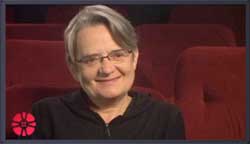
Click here to view
Agnieszka Holland's
DGA Visual History interview.